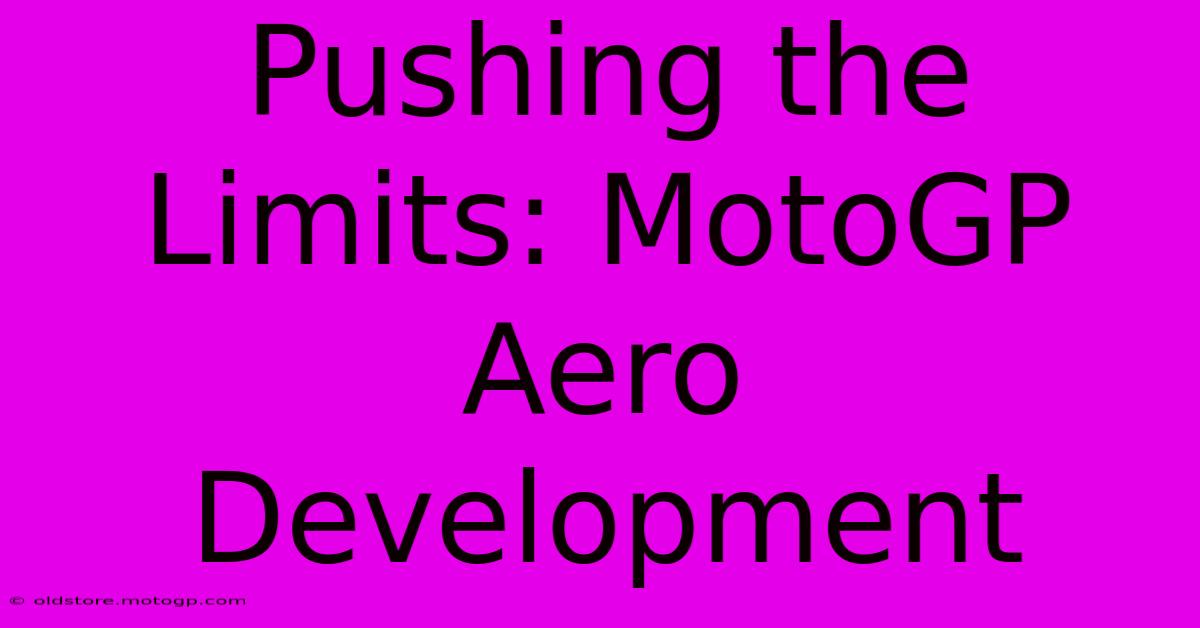Pushing The Limits: MotoGP Aero Development

Table of Contents
Pushing the Limits: MotoGP Aero Development
The roar of the engines, the blur of speed, the breathtaking lean angles – MotoGP is a spectacle of precision and power. But beneath the surface of thrilling races lies a constant battle for aerodynamic advantage. MotoGP aero development is a relentless pursuit of marginal gains, pushing the boundaries of physics and engineering to shave milliseconds off lap times and secure crucial victories. This article delves into the fascinating world of MotoGP aerodynamics, exploring its evolution, current trends, and future possibilities.
The Evolution of MotoGP Aerodynamics
Early MotoGP bikes were relatively unburdened by complex aerodynamic aids. The focus was primarily on engine power and rider skill. However, as speeds increased and competition intensified, the importance of aerodynamics became undeniable.
From Simple Winglets to Complex Appendages
The first noticeable aerodynamic additions were simple winglets, initially introduced to improve stability at high speeds. These early iterations were relatively small and served a primarily functional purpose. But as understanding of airflow dynamics deepened, winglets evolved into more complex and sophisticated designs.
The Role of Computational Fluid Dynamics (CFD)
Modern MotoGP aero development relies heavily on Computational Fluid Dynamics (CFD). This sophisticated simulation technology allows engineers to virtually test different designs, predicting their performance before ever building a physical prototype. This significantly reduces development time and cost, enabling teams to explore a wider range of aerodynamic solutions.
The Arms Race: Continuous Innovation
The continuous development of MotoGP aerodynamics has created an ongoing "arms race" among manufacturers. Each team strives to discover innovative solutions to improve downforce, reduce drag, and enhance rider stability. This competitive environment fuels innovation, pushing the boundaries of what's possible.
Current Trends in MotoGP Aero Development
Current trends in MotoGP aero development are focused on several key areas:
Maximizing Downforce While Minimizing Drag
The ultimate goal is to generate as much downforce as possible while minimizing drag. Downforce keeps the bike glued to the track at high speeds, enabling greater lean angles and faster cornering. Minimizing drag, conversely, allows for higher top speeds on straights. This delicate balance is crucial for overall performance.
Sophisticated Winglet Designs
Modern winglets are far more sophisticated than their predecessors. They incorporate intricate shapes and angles designed to manipulate airflow precisely. Some designs incorporate multiple elements working in conjunction to optimize downforce and drag reduction.
Aero Fairings and Bodywork Integration
Aero fairings and bodywork are not merely protective shells. They are integral parts of the aerodynamic system, carefully shaped to manage airflow around the bike and rider. Every curve and surface is meticulously designed to contribute to overall aerodynamic performance.
Rider Ergonomics and Aero Integration
The interaction between the rider and the bike's aerodynamics is critical. Modern designs consider the rider's position and body shape to optimize airflow around both the bike and rider, further enhancing performance.
The Future of MotoGP Aerodynamics
The future of MotoGP aero development promises even more exciting advancements.
Active Aerodynamics
The possibility of active aerodynamics – systems that adjust their shape and position depending on track conditions and speed – is a significant area of research. This technology could significantly improve performance and adaptability.
Material Innovation
New materials with enhanced aerodynamic properties, such as lighter and stronger composites, will play a crucial role in future designs. This allows for more complex and efficient aerodynamic solutions.
AI and Machine Learning
AI and machine learning are increasingly being used to optimize aerodynamic designs and improve the efficiency of CFD simulations. This enables more rapid and effective design iterations.
Conclusion: A Continuous Pursuit of Perfection
MotoGP aero development is a dynamic and ever-evolving field. The constant push for marginal gains, coupled with technological advancements, ensures that the sport remains at the forefront of aerodynamic innovation. The pursuit of perfect balance between downforce and drag is a testament to human ingenuity and the relentless quest for speed. The future of MotoGP aerodynamics is bright, promising even more thrilling battles on the track.

Thank you for visiting our website wich cover about Pushing The Limits: MotoGP Aero Development. We hope the information provided has been useful to you. Feel free to contact us if you have any questions or need further assistance. See you next time and dont miss to bookmark.
Featured Posts
-
Cota Austin Schedule Dont Miss Out
Feb 24, 2025
-
Cota Qualifying The Tension Builds
Feb 24, 2025
-
Experience The G Force Austin Gp Sprint Race Power
Feb 24, 2025
-
Cota Lot H Risk Free Trial
Feb 24, 2025
-
F1 Austin The Ultimate Fusion Of Music And Motorsports
Feb 24, 2025
